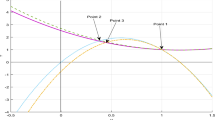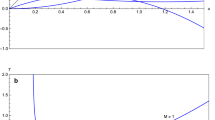Summary
In this paper, we have postulated, in a conducting gas, the occurrence of a boundary shock wave, considered as a quick transition region in which the viscous effects are compressive and are confined to a thin layer adjacent to a surface. The analogues of the well known Rankine-Hugoniot jump relations, Prandtl relation, and other properties of a shock wave are derived and a discussion about the existence of a boundary shock wave is made.
Similar content being viewed by others
References
E. D. Martin, J. Fluid Mech.28 (1967), 337–352.
K. O. Friedrichs, Bull. Amer. Math. Soc.61 (1955), 485–504.
H. W. Liepmann andA. Roshko,Elements of Gas Dynamics (John Wiley & Sons Inc., N.Y. 1957).
W. D. Hayes,Gas Dynamic Discontinuties, Princeton Aeronautical Paper Backs (Princeton Univ. Press, Princeton, N.J. 1960).
Author information
Authors and Affiliations
Rights and permissions
About this article
Cite this article
Verma, B.G., Prasad, B. Boundary shock waves in a conducting gas. PAGEOPH 87, 203–209 (1971). https://doi.org/10.1007/BF00878924
Received:
Revised:
Issue Date:
DOI: https://doi.org/10.1007/BF00878924




